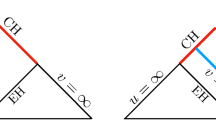Abstract
We analyze the thermodynamical properties of the regular static and spherically symmetric black hole interior model presented by Mbonye and Kazanas. Equations for the thermodynamical quantities valid for an arbitrary density profile are deduced, and from them we show that the model is thermodynamically unstable. Evidence is also presented pointing to its dynamical instability. The gravitational entropy of this solution based on the Weyl curvature conjecture is calculated, following the recipe given by Rudjord, Grøn and Sigbjørn, and it is shown to have the expected behavior.
















Similar content being viewed by others
Notes
As shown in [27], in order to satisfy the TOV equation, the anisotropic pressure must be introduced when dealing with static spherically symmetric space-times and perfect fluids with negative pressures in some interval of the radial coordinate as a source.
This value of α is chosen to yield a sound speed bounded by the speed of light [17].
MK assumes implicitly that ρ=0 for r>R, although this is not strictly correct. The cutoff in the density profile, however, is sufficiently strong as to consider this approximation correct from any practical point of view.
Although this profile resembles the qualitative plot for the radial pressure in a gravastar (see [27]), it must be noted that the MK model has an horizon, which is absent in gravastars.
See reference [26] for other space-times.
To simplify the notation, we shall set the constant k s equal to 1 since it plays in what follows the role of a scale factor.
We choose the constant of integration so that δA(r,t)=0 if δr=0.
References
Earman, J.: Bangs, crunches, whimpers and shrieks: singularities and acausalities in Relativistic Spacetimes. Oxford University Press, USA (1995)
Novello, M., Perez Bergliaffa, S.E.: Bouncing cosmologies. Phys. Rep. 463, 127–213 (2008)
Markov, M.A.: Limiting density of matter as a universal law of nature. Pis’ma Zh. Eksp. Teor. Fiz. 36, 214–216 (1982)
Penrose, R.: Gravitational collapse and space-time singularities. Phys. Rev. Lett. 14, 57–59 (1965)
Hawking, S.W., Penrose, R.: The singularities of gravitational collapse and cosmology. Proc. R. Soc. Lond. Math. A 314, 529–548 (1970)
Hawking, S.W., Ellis, G.R.: The cosmic black-body radiation and the existence of singularities in our universe. Astrophys. J. 152, 25–36 (1968)
Brandenberger, R.H., Mukhanov, V.F., Sornborger, A.: Cosmological theory without singularities. Phys. Rev. D 48, 1629–1642 (1993)
Gliner, E.: Algebraic properties of the energy-momentum tensor and vacuum-like states o+ matter. Sov. Phys. JETP 22, 378 (1966)
Sakharov, A.D.: Expanding universe and the appearance of a nonuniform distribution of matter. Sov. Phys.-JETP 22, 241–249
Zeldovich, Y.B.: Special Issue: the cosmological constant and the theory of elementary particles. Sov. Phys. Usp. 11, 381–393 (1968)
Bardeen, J.M.: Non-singular general-relativistic gravitational collapse. In: Fock, V.A. (ed.) Proc. of GR5, p. 174. Tbilisi University Press, Tbilisi (1968)
Poisson, E., Israel, W.: Structure of the black hole nucleus. Class. Quantum Gravity 5, L201–L205 (1988)
Frolov, V.P., Markov, M.A., Mukhanov, V.F.: Through a black hole into a new universe? Phys. Lett. B 216, 272–276 (1989)
Frolov, V.P., Markov, M.A., Mukhanov, V.F.: Black holes as possible sources of closed and semiclosed worlds. Phys. Rev. D 41, 383–394 (1990)
Dymnikova, I.: Spherically symmetric space time with regular de Sitter center. Int. J. Mod. Phys. D 12, 1015–1034 (2003)
Dymnikova, I.: Vacuum nonsingular black hole. Gen. Relativ. Gravit. 24, 235–242 (1992)
Mbonye, M.R., Kazanas, D.: Nonsingular black hole model as a possible end product of gravitational collapse. Phys. Rev. D 72, 024016 (2005)
Lemos, J.P.S., Zanchin, V.T.: Regular black holes: Electrically charged solutions, Reissner-Nordström outside a de Sitter core. Phys. Rev. D 83, 124005 (2011)
Bronnikov, K.A., Fabris, J.C.: Regular phantom black holes. Phys. Rev. Lett. 96, 251101 (2006)
Bronnikov, K.A., Dehnen, H., Melnikov, V.N.: Regular black holes and black universes. Gen. Relativ. Gravit. 39, 973–987 (2007)
Mbonye, M.R., Battista, N., Farr, B.: Time evolution of a non-singular primordial black hole. Int. J. Mod. Phys. D 20, 1–18 (2011)
Saridakis, E.N., González-Díaz, P.F., Sigüenza, C.: Unified dark energy thermodynamics: varying ω and the -1-crossing. Class. Quantum Gravity 26, 165003–165008 (2009)
Dymnikova, I., Korpusik, M.: Thermodynamics of regular cosmological black holes with de Sitter interior. AIP Conf. Proc. 17, 35–37 (2011)
Silva, R., Gonaçalves, R.S., Alcaniz, J.S., Silva, H.H.B.: Thermodynamics and dark energy. Astron. Astrophys. 576, A11 (2011)
Rudjord, Ø., Grøn, Ø., Sigbjørn, H.: The Weyl curvature conjecture and black hole entropy. Phys. Scr. 77, 055901 (2008)
Romero, G.E., Thomas, R., Pérez, D.: Gravitational entropy of black holes and wormholes. Int. J. Theor. Phys. 51, 925–942 (2012)
Cattoen, C., Faber, T., Visser, M.: Gravastars must have anisotropic pressures. Class. Quantum Gravity 22, 4189–4202 (2005)
Horvat, D., Ilijic, S., Marunovic, A.: Radial stability analysis of the continuous pressure gravastar. Class. Quantum Gravity 28, 025009 (2011)
Misner, C.W., Thorne, K.S., Wheeler, J.A.: Gravitation. Freeman, San Francisco (1973)
Penrose, R.: In: Hawking, S.W., Israel, W. (eds.) Singularity and time-asymmetry in General Relativity, an Einstein centenary survey, pp. 581–638. Cambridge Univ. Press, Cambridge (1979)
Grøn, Ø.: Entropy and gravity. Entropy 14, 2456–2477 (2012)
Clifton, T., Ellis, G.F.R., Tavakol, R.: A gravitational entropy proposal. Class. Quantum Gravity 30(12), 125009 (2013)
Bekenstein, J.D.: Generalized second law of thermodynamics in black-hole physics. Phys. Rev. D 9, 3292–3300 (1974)
Hillebrandt, W., Steinmetz, K.: Anisotropic neutron star models—Stability against radial and nonradial pulsations. Astron. Astrophys. 53, 283–287 (1976)
Morse, M., Fesbach, M.: Methods of Theoretical Physics. McGraw-Hill Science, USA (1953)
Zettl, A.: Sturm-Liouville Theory. Mathematical Surveys and Monographs, vol. 121. American Mathematical Society, Providence (2005)
Acknowledgements
BH astrophysics with G.E. Romero is supported by the Argentine agencies ANPCyT (BID 1728/0C-AR PICT-2012-00878) and CONICET (PIP 0078/2010), as well as the Spanish grant AYA 2010-21782-C03-01. SEPB would like to acknowledge support from UERJ, FAPERJ, and ICRANet-Pescara. We are grateful to Camila A. Correa for early contributions to this research.
Author information
Authors and Affiliations
Corresponding author
Appendix: Dynamical Stability of the Interior Region
Appendix: Dynamical Stability of the Interior Region
In order to study the stability of a system with tangential pressures against radial perturbations, both Einstein field equations and the equation of state must be perturbed following the standard procedure (see for instance [34]). The goal is to obtain a differential equation for the radial dependence of the quantity ξ(r,t), which represents a small radial displacement of the fluid respect to its position of equilibrium at time t, that is, r(r,t)=r 0+ξ(r,t).
In what follows, the unperturbed metric coefficients A(r), B(r), and the unpertubed thermodynamics variables will be denoted by a zero subindex. The corresponding perturbations are denoted by δA(r,t), δB(r,t), δp r (r,t), δp ⊥(r,t) and δρ(r,t). A long but straightforward calculation (which parallels that presented in [34]) shows that the equations for the perturbations are given by:
Notice that there are six unknowns in this system, a consequence of the choices made by MK (one EOS and the explicit form of ρ(r) to determine the system).
Equation (45) can be integrated respect to time,Footnote 9 yielding:
By isolating δB from (46) we get:
The final set of equations takes the form:
Standard manipulations using the expression ξ(r,t)=σ(r)expiωt in these equations lead to the following second order ordinary inhomogeneous differential equation for the function σ(r):
where we have also used δp ⊥(r,t)=Π(r)expiωt.
This equation defines an inhomogeneous Sturm-Liouville (SL) problem, differently from the common case which yields a homogeneous one, the inhomogeneity being a direct consequence of the way the MK model solution was obtained, as mentioned before.
Equation (55) is to be solve for r∈[0,1], using the boundary conditions σ(r)=0, σ(1)=0, and \([\delta\rho(1,t)+\rho '_{0}(1,t) \xi(1,t) ] = 0\) [34]. The coefficients A ⋆(r), B ⋆(r), C ⋆(r), and D ⋆(r) are given by:
where:
For a given Π(r), (55) might be solved using the Green’s function method (see for instance [35]). However, as we shall show next, the SL problem defined by (55) has a singular point. Consider the equation [36]:
which corresponds to the homogeneus SL problem defined on J=(a,b), with −∞≤a≤b≤∞. The eigenvalue λ is such that \(\lambda\in\mathbb{C}\), and p,q,w and y are functions of x. It is also assumed that:
where \(L_{\mathrm{loc}} (J,\mathbb{C} )\) denotes the linear manifold of functions y satisfying \(y \in L ( [\alpha,\beta ],\mathbb{C} )\) for all compact intervals [α,β]⊆J. \(L (J,\mathbb{C} )\) denotes the linear manifold of complex valued Lebesgue measurable functions y defined on J for which: \(\int_{a}^{b} \vert y(t)\vert dt \equiv\int_{J} \vert y(t)\vert dt \equiv\int_{J} \vert y(t)\vert < \infty\).
Here J is any interval of the real line, open, closed, half open, bounded or unbounded. Following [36], we have the next definitions:
-
The (finite or infinite) endpoint a is regular if
$$ \frac{1}{p}, q, w \in L\bigl((a,d),\mathbb{C}\bigr), $$(69)holds for some (hence any) d∈J.
-
An endpoint is called singular if it is not regular,
with similar definitions at r=b. To analyse whether a=0 is a regular or singular endpoint for our problem, defined by (55), we show in Fig. 17 the plot of the coefficient A ⋆ as a function of radial coordinate. We can see that A ⋆(0)=A ⋆(0.4)=0, A ⋆(r)<0 for r∈(0,0.4), and A ⋆(r)>0 for r∈(0.4,1). Hence, \(\frac {1}{A}_{\star} \notin L((0,d),\mathbb{C})\) for any d∈(0,1). Therefore, the endpoint a=0 is singular. If an endpoint is singular it could be a limit point or a limit circle. According to [36], “there is hardly any literature on the LP/LC (limit point-limit circle) dichotomy when all three coefficients are present in the SL equation”. In particular, “there seems to be no literature on LP/LC criteria when p changes sign”. Due to these complications, we shall attack this problem in a future publication.
Rights and permissions
About this article
Cite this article
Pérez, D., Romero, G.E. & Perez-Bergliaffa, S.E. An Analysis of a Regular Black Hole Interior Model. Int J Theor Phys 53, 734–753 (2014). https://doi.org/10.1007/s10773-013-1861-3
Received:
Accepted:
Published:
Issue Date:
DOI: https://doi.org/10.1007/s10773-013-1861-3





